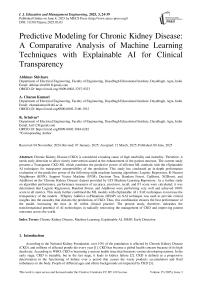Predictive Modeling for Chronic Kidney Disease: A Comparative Analysis of Machine Learning Techniques with Explainable AI for Clinical Transparency
Автор: Abhinav Shivhare, A. Charan Kumari, K. Srinivas
Журнал: International Journal of Education and Management Engineering @ijeme
Статья в выпуске: 3 vol.15, 2025 года.
Бесплатный доступ
Chronic Kidney Disease (CKD) is considered a leading cause of high morbidity and mortality. Therefore, it needs early detection to allow timely intervention aimed at the enhancement of the patient outcome. The current study presents a Transparent CKD ML which combines the predictive power of efficient ML methods with the eXplainable AI techniques for transparent interpretibility of the prediction. This study has conducted an in-depth performance evaluation of the predictive power of the following eight machine learning algorithms: Logistic Regression, K-Nearest Neighbours (KNN), Support Vector Machine (SVM), Decision Tree, Random Forest, CatBoost, XGBoost, and AdaBoost on the 'Chronic Kidney Disease' dataset provided by UCI Machine Learning Repository. As a further study on algorithm performance, performance measures of accuracy, precision, recall, and F1 score were calculated; it was determined that Logistic Regression, Random Forest, and AdaBoost were performing very well and achieved 100% score in all metrics. This study further combined the ML models with eXplainable AI ( XAI) techniques to increase the transparency of the models. SHapley Additive exPlanations (SHAP) an XAI technique was used to provide critical insights into the causality that dictates the predictions of CKD. Thus, this combination ensures the best performance of the model, increasing the trust in AI within clinical practice. The present study, therefore, unleashes the transformational potential of AI technologies in radically renovating the management of CKD and improving patient outcomes across the world.
Chronic Kidney Disease, Machine Learning, Explainable AI, SHAP, Early Detection
Короткий адрес: https://sciup.org/15019861
IDR: 15019861 | DOI: 10.5815/ijeme.2025.03.03


